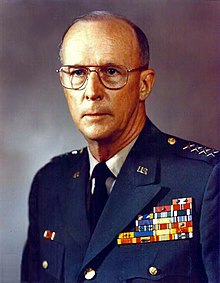Walter T. Kerwin, Jr.
| Walter T. Kerwin, Jr. | |
|---|---|
 |
|
| Nickname(s) | "Dutch" |
| Born |
June 14, 1917 West Chester, Pennsylvania |
| Died | July 11, 2008 (aged 91) Alexandria, Virginia |
| Allegiance |
|
| Service/branch |
|
| Years of service | 1939–1978 |
| Rank |
|
| Commands held | Forces Command |
| Battles/wars |
World War II Vietnam War |
| Awards |
Legion of Merit (2) Bronze Star Air Medal (11) Purple Heart |
Walter Thomas Kerwin, Jr. (June 14, 1917 – July 11, 2008) was a United States Army four star general who served as Commanding General, U.S. Continental Army Command (CG CONARC), 1973; Commanding General, United States Army Forces Command (CG FORSCOM) from 1973 to 1974; and Vice Chief of Staff, U.S. Army (VCSA) from 1974 to 1978. He was the first commander of United States Army Forces Command and a member of the Association of the United States Army’s Advisory Board of Directors since 1984.
Kerwin graduated from the United States Military Academy in 1939 and was commissioned in the field artillery and assigned to the 3rd Infantry Division. During World War II he fought in North Africa, Sicily, Italy and France. In December 1944, while in France, he was wounded in Mutzig and evacuated to the United States, returning to Europe in 1945 and assigned to the Theater Operations Division of the War Department's General Staff.
As a brigadier general he took command of the 3rd Armored Division Artillery in Hanau, Germany in August 1961. During the 1960s he held various flag officer billets to include Chief of Staff, Military Assistance Command, Vietnam (MACV), Commander, II Field Force, Vietnam, Deputy Chief of Staff of the Army for Personnel, and Commanding General of the Continental Army Command, later renamed Forces Command.
Kerwin is heralded as the champion of the “One Army” or “Total Army” concept. This concept, which became a reality under his leadership, recognized the indispensable role of the Army National Guard and U.S. Army Reserve as equal partners with the active Army in executing defense policy and in preparing for war.
Recognized by his commanders and peers as an innovative artilleryman, he developed a system of massing fires that contributed immeasurably to the success of the Allied landings at Anzio Beachhead. After World War II, he attended the Army War College and the National War College, and served in various assignments, including Plans and Operations Officer at the Los Alamos Scientific Laboratory; Commander of the 56th Artillery Group, XVIII Airborne Corps; and Deputy Director in the Army's Office of the Chief of Research and Development.
...
Wikipedia
